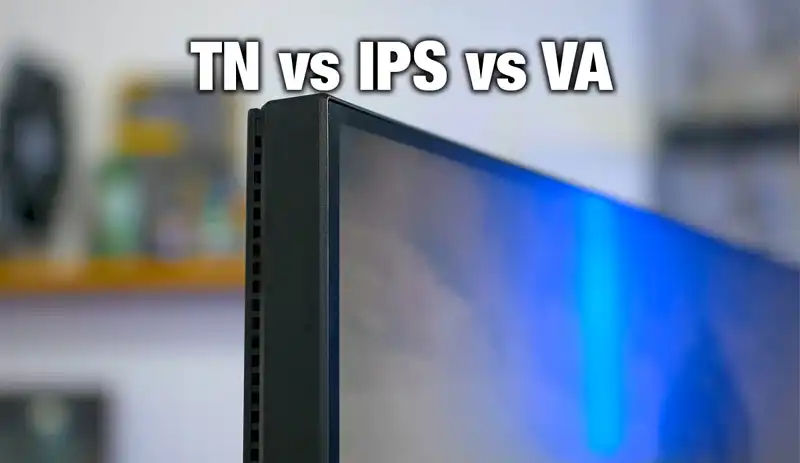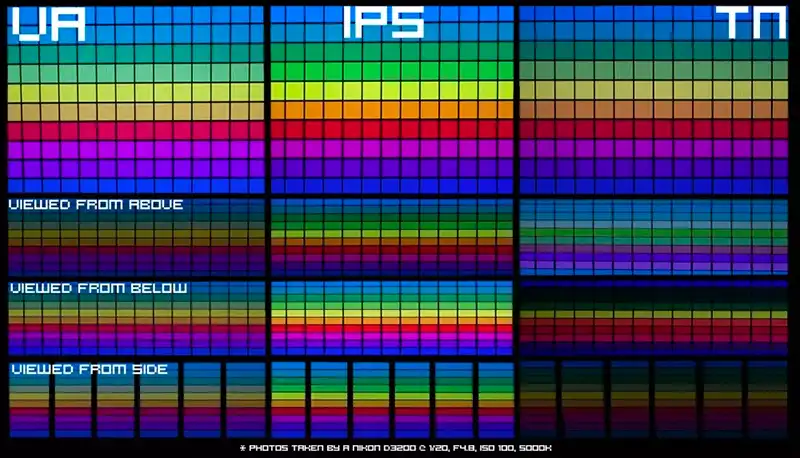You can also be interested in these:
- HDMI vs DisplayPort: What is the best display interface?
- Do you need a PC for a monitor to work properly?
- Asus ROG Swift PG27AQN full review
- Can a monitor work without a PC attached to it?
When choosing a monitor for gaming, there are several factors to consider. However, the type of panel is the most important aspect to consider, as it determines the monitor’s characteristics. Here we will explain how TN, IPS, and VA panels affect monitor quality.

When we find ourselves needing to purchase a monitor, it’s common to pay attention to resolution, refresh rate, and connectivity. However, these factors are highly influenced by the type of panel used in the manufacture of the monitor. Therefore, it’s important to know the type of panel used in a monitor or laptop.
What types of screen display panels exist?
Laptops and monitors use three basic types of panels: TN vs IPS vs VA. Each type of panel has its advantages and disadvantages, and there is no perfect panel. That’s why we will give you a detailed description of the different types of panels and how they affect the gaming experience.
Twisted Nematic (TN) panels
The Twisted Nematic (TN) panel is the most economical to manufacture, so it is mainly used in low-cost monitors. It is characterized by fast refresh rates and short response times.
We may find monitors that offer refresh rates of up to 144 Hz or 240 Hz and response times of 1 ms, ensuring smooth movement, no “motion blur”, and no ghosting effect. “Motion blur” occurs when the moving object (whether it be a character or not) appears blurry, while the ghosting effect appears to be using two characters at the same time.
In addition, monitors with TN panels are characterized by high-quality blacks, which provides us with greater clarity in dark areas. This is one of the great advantages they have over IPS panels.
However, color quality is one of the major disadvantages of TN panels. Generally, they have a poorer color palette and the colors look faded. In addition, they usually have a contrast of 1000:1 and a brightness of 250 nits, which is not very favorable. In addition, the viewing angles are usually 160-170 degrees, which is another point against.
In-Plane Switching (IPS) panels
In terms of IPS panels, these show the colors of the images much more accurately. They offer a color depth of up to 8 bits, and have a color depth that is up to 30% greater than that of TN panels.
The viewing angles on IPS panels are much better, with 178 degree viewing without losing image quality or altering color. Due to these advantages, it’s not surprising that their price is higher than TN panels.
The IPS panel often offers refresh rates of 165 Hz, but some reach 240 Hz. However, these are usually expensive and scarce. On the other hand, IPS panel response times are generally 5 ms, although some monitors offer shorter response times, but they tend to be costly.
One of the disadvantages of this type of panel is the representation of blacks, which tend to be less intense, which can result in the loss of details in dark areas. VA and TN panels are better in this aspect.
In addition, IPS panels can exhibit the problem known as IPS Glow, which is an increase in brightness when viewing the screen from a wider angle.
Vertical Alignment (VA) Panels
VA panels are a middle solution between TN and IPS panels, combining the best aspects of both types. They can be found in 4K resolution gaming monitors for those seeking image quality.
These panels offer refresh rates higher than 200 Hz, which eliminates ghosting. They also provide excellent color representation with vivid colors and contrast ratios of 3000:1 or more. They are ideal for those looking to enjoy games with high graphic quality and plot.
The negative aspect of these panels lies in their response times, which are somewhat of a mid-term between TN and IPS panels. These panels offer response times of 2-3 ms, although there are some that are even faster.
Price is probably one of the biggest obstacles with VA panels. These monitors are really expensive, meaning it’s difficult to find gaming monitors with a resolution lower than 4K.

What is the best screen display for gaming?
It really depends, as each panel offers something different. The truth is, you need to consider what type of games you will be focusing on. This can be challenging as any player may have a wide variety of genres and games in their collection.
TN panels typically offer better refresh rates and response times. The image color quality tends to be a bit desaturated, which places them at the lower end of the price and preference scale, but they shine in contrast with blacks. Another drawback is that they lose a bit of sharpness when viewed from an angle.
Monitors with IPS panels don’t tend to have very good refresh rates, although technology has put them in a very balanced position and on par with the average market. Something that doesn’t work in their favor is the density of blacks, as the image doesn’t have much contrast. On the other hand, IPS panels are quite affordable, making monitors a bit cheaper in terms of price.
Finally, we could say that monitors with VA panels are a mix between TN and IPS screens. Refresh rates are mostly high, above 200 Hz, but response times are not as high. As time goes by, we see more VA monitors with 1 ms response times, so this is not a problem today. These are usually more expensive and are mostly seen in high-end 4K and curved monitors for gaming.
More stories like this
- HDMI vs DisplayPort: What is the best display interface?
- Do you need a PC for a monitor to work properly?
- Asus ROG Swift PG27AQN full review
- Can a monitor work without a PC attached to it?
- DVI-I vs DVI-D: Which is better and why? (Explained)
- How to repair a dead pixel on your screen?